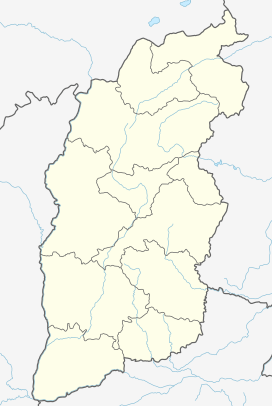Gu County
Gu County or Guxian (simplified Chinese: 古县; traditional Chinese: 古縣; pinyin: Gǔ Xiàn) is a county in the south of Shanxi Province, China, under the administration of the prefecture-level city of Linfen.[1] The county spans an area of 1,196 square kilometers, and has a population of 91,798 as of 2010.[1][2]
Gu County 古县 | |
|---|---|
County | |
 Guxian Location of the seat in Shanxi | |
| Coordinates: 36°16′03″N 111°55′11″E | |
| Country | People's Republic of China |
| Province | Shanxi |
| Prefecture-level city | Linfen |
| Area | |
| • Total | 1,196 km2 (462 sq mi) |
| Population (2010)[2] | |
| • Total | 91,798 |
| • Density | 77/km2 (200/sq mi) |
| Time zone | UTC+8 (China Standard) |
| Postal code | 042400 |
| Website | http://www.guxian.gov.cn/ |
History
The area was first incorporated under Emperor Xiaozhuang of the Northern Wei Dynasty in 528 CE under the name Anze County (安泽县).[3] The county was placed under the administration of Qinzhou upon its formation in 596 CE, during the Sui Dynasty.[3]
In 606 CE the Anze County was renamed to Yueyang County (岳阳县).[3] Yueyang County underwent numerous boundary changes, but retained its name until 1914, when its name was reverted to Anze County.[3] During the Republic of China, the county belonged to Hedong Circuit, but underwent various reorganizations during the Japanese Invasion of China.[3]
In August 1971, Gu County was formed with seven townships from Anze County and three from Fushan County.[3] In 1973, the county center was built up from Zhangjiagou Village (张家沟村) and Wanli Village (湾里村).[3]
Geography
Gu County spans an area of 1,196 kilometers, and ranges in altitude from 590 meters to 2,346 meters in height.[1] The main rivers which flow through the county include the Jian River, the Shibi River, the Lin River, the Guxian River, and the Caizi River.[1]
Administrative divisions
The county is divided into four towns and three townships.[1][4] The county government is stationed in the town of Yueyang.[1]
The county's four towns are Yueyang, Beiping, Guyang, and Jiuxian.[1][4]
The county's three townships are Shibi Township, Yongle Township, and Nanyuan Township.[1][4]
References
- 古县概况地图. xzqh.org (in Chinese). 2016-10-18. Archived from the original on 2019-05-13. Retrieved 2020-06-27.
- 临汾市2010年第六次全国人口普查主要数据公报. web.archive.org (in Chinese). 2011-06-16. Archived from the original on 2013-08-17. Retrieved 2020-06-27.
- 历史渊源. Gu County People's Government Web Portal (in Chinese). 2013-06-20. Archived from the original on 2015-04-07. Retrieved 2020-06-27.
- 2019年统计用区划代码. www.stats.gov.cn (in Chinese). 2019. Archived from the original on 2020-06-27. Retrieved 2020-06-27.